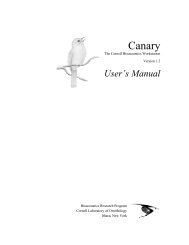Home Study Course in Bird Biology - Cornell Lab of Ornithology
Home Study Course in Bird Biology - Cornell Lab of Ornithology
Home Study Course in Bird Biology - Cornell Lab of Ornithology
Create successful ePaper yourself
Turn your PDF publications into a flip-book with our unique Google optimized e-Paper software.
<strong>Home</strong> <strong>Study</strong> <strong>Course</strong><strong>in</strong> <strong>Bird</strong> <strong>Biology</strong>Interpret<strong>in</strong>g and conserv<strong>in</strong>g the earth’s biological diversity throughresearch, education, and citizen science focused on birds.
Do you know …Illustrations by John Schmitt © 2002 <strong>Cornell</strong> <strong>Lab</strong> <strong>of</strong> <strong>Ornithology</strong>Why this DownyWoodpecker iswhite?What this owl is do<strong>in</strong>g?Why male Mallards “disappear”<strong>in</strong> late summer?Why a Ruby-throated Humm<strong>in</strong>gbird’s throatpatch appears to flash on and <strong>of</strong>f?Why mock<strong>in</strong>gbirdsmimic other birds?You’ll learn the answers <strong>in</strong> the …Frequency (kilohertz)Frequency (kilohertz)Sonogram <strong>of</strong> KilldeerSecondsSonogram <strong>of</strong> Northern Mock<strong>in</strong>gbirdmimick<strong>in</strong>g KilldeerSecondsEasternMeadowlarkYellow-throatedLongclawWhy some unrelated species fromdifferent parts <strong>of</strong> the worldlook so much alike?…Second Edition<strong>of</strong> the <strong>Cornell</strong> <strong>Lab</strong> <strong>of</strong> <strong>Ornithology</strong>’sL<strong>Home</strong> <strong>Study</strong> <strong>Course</strong>!earn about bird behavior, ecology,conservation, and many other subjects—<strong>in</strong> your own home, at your own pace, withno deadl<strong>in</strong>es! This comprehensive course was writtenby twelve lead<strong>in</strong>g ornithologists, edited by <strong>Lab</strong><strong>of</strong> <strong>Ornithology</strong> staff, and illustrated by acclaimedwildlife artist John Schmitt. The course is writtenat the <strong>in</strong>troductory college level, but is suitable foranyone with an <strong>in</strong>quir<strong>in</strong>g m<strong>in</strong>d and a serious <strong>in</strong>terest<strong>in</strong> birds. It <strong>in</strong>troduces important biological conceptsby explor<strong>in</strong>g the major topics <strong>in</strong> ornithology. Currentand past students <strong>in</strong>clude bird watchers <strong>of</strong> all skilllevels as well as high school and college students,pr<strong>of</strong>essional biologists, wildlife rehabilitators, andhomeschoolers.Sign up for the course and receive:• A 1,300-page textbook, generouslyillustrated with detailed figures andblack-and-white photos• An audio CD <strong>of</strong> bird sounds toaccompany the chapter on VocalBehavior• Choice <strong>of</strong> onl<strong>in</strong>e exams through e<strong>Cornell</strong>or paper exams• Complete <strong>in</strong>structor supportAfter you have read and studied each <strong>of</strong> theten chapters and completed all <strong>of</strong> the correspond<strong>in</strong>gexams successfully, you will receivea Certificate <strong>of</strong> Completion signed by the director <strong>of</strong>the <strong>Cornell</strong> <strong>Lab</strong> <strong>of</strong> <strong>Ornithology</strong>.
<strong>Bird</strong>s and Humans: A Historical PerspectiveSandy Podulka, Marie Eckhardt, and Dan Otis,<strong>Cornell</strong> UniversityThe role <strong>of</strong> birds <strong>in</strong> historical and contemporary humansocieties • <strong>Bird</strong>s <strong>in</strong> religion, folklore, art, and literature• <strong>Bird</strong>s and early natural scienceIntroduction: The World <strong>of</strong> <strong>Bird</strong>sKev<strong>in</strong> J. McGowan, <strong>Cornell</strong> UniversityWhat is a bird? • The diversity <strong>of</strong>bird forms • Current theories onthe evolution <strong>of</strong> birds and feathersA Guide to <strong>Bird</strong> Watch<strong>in</strong>gStephen W. Kress, AudubonHow to identify birds <strong>in</strong> the fieldby size, shape, sound, color,behavior, and field marks• Choos<strong>in</strong>g and us<strong>in</strong>gb<strong>in</strong>oculars and spott<strong>in</strong>g scopesBlack-billedScythebillForm and Function: The External <strong>Bird</strong>George A. Clark, Jr., University <strong>of</strong> ConnecticutFeathers: Their structure, function, and care • Nonfeatheredareas • Molts and plumages • How colors areproducedWhat’s Inside: Anatomy and PhysiologyHoward E. Evans and John B. Heiser, <strong>Cornell</strong> UniversitySkeletons, muscles, and <strong>in</strong>ternal organs • The nervoussystem and senses, circulation and respiration, hormonesand reproduction, digestion and excretion<strong>Bird</strong>s on the Move: Flight and MigrationKenneth P. Able, SUNY AlbanyUnderstand<strong>in</strong>g how birds fly • Hover<strong>in</strong>g, soar<strong>in</strong>g, fly<strong>in</strong>g <strong>in</strong>formation • Why and how do birds migrate and navigate?The <strong>Cornell</strong> <strong>Lab</strong> <strong>of</strong> <strong>Ornithology</strong> is a membership <strong>in</strong>stitutededicated to <strong>in</strong>terpret<strong>in</strong>g and conserv<strong>in</strong>g the earth’s biologicaldiversity through research, education, and citizenscience focused on birds. The <strong>Lab</strong> and <strong>Cornell</strong> Universitytogether provide an <strong>in</strong>ternational center for tra<strong>in</strong><strong>in</strong>g bothamateurs and pr<strong>of</strong>essionals <strong>in</strong> the ecology, evolutionarybiology, and conservation <strong>of</strong> birds.<strong>Course</strong> OverviewEvolution <strong>of</strong> <strong>Bird</strong>s and Avian FlightAlan Feduccia, University <strong>of</strong> North Carol<strong>in</strong>aArchaeopteryx and the fossil record <strong>of</strong> birds • Theories onthe evolution <strong>of</strong> avian flightUnderstand<strong>in</strong>g <strong>Bird</strong> BehaviorJohn Alcock, Arizona State UniversityInst<strong>in</strong>ct and learn<strong>in</strong>g • Social behavior, displays and theirfunctions, mat<strong>in</strong>g systems • Understand<strong>in</strong>g behaviorthrough the theories <strong>of</strong> natural selection and evolutionVocal BehaviorDonald E. Kroodsma, University <strong>of</strong> MassachusettsThe diversity <strong>of</strong> bird sounds explored and expla<strong>in</strong>edthrough sonagrams and an accompany<strong>in</strong>g audio cassettetape or compact disc • <strong>Bird</strong> songs, calls, and their functionsNests, Eggs, and Young: Breed<strong>in</strong>g <strong>Biology</strong> <strong>of</strong> <strong>Bird</strong>sDavid W. W<strong>in</strong>kler, <strong>Cornell</strong> UniversityNest types, eggs, and patterns <strong>of</strong> clutch variability • Roles<strong>of</strong> the sexes dur<strong>in</strong>g nest<strong>in</strong>g • Development <strong>of</strong> young, nestl<strong>in</strong>gcare • Brood parasitism • Evolution <strong>of</strong> nest<strong>in</strong>g behaviorIndividuals, Populations, and Communities:The Ecology <strong>of</strong> <strong>Bird</strong>sStanley A. Temple, University <strong>of</strong> Wiscons<strong>in</strong>How birds <strong>in</strong>teract with their physical and liv<strong>in</strong>g environments• Feed<strong>in</strong>g ecology, how ecosystems work, ecologicalniches • <strong>Bird</strong> associations: population dynamics,communities, symbiosis<strong>Bird</strong> ConservationJohn W. Fitzpatrick, <strong>Cornell</strong> UniversityThe importance <strong>of</strong> biodiversity • Why and how birds decl<strong>in</strong>e<strong>in</strong> number, become endangered, go ext<strong>in</strong>ct • Legalaspects <strong>of</strong> conservation: the Endangered Species Act •Conservation success stories<strong>Lab</strong> members receive many benefits, <strong>in</strong>clud<strong>in</strong>g• Liv<strong>in</strong>g <strong>Bird</strong>—An award-w<strong>in</strong>n<strong>in</strong>g magaz<strong>in</strong>e featur<strong>in</strong>g bird biology,conservation, art, and recreation• <strong>Bird</strong>Scope—A unique newsletter report<strong>in</strong>g the latest f<strong>in</strong>d<strong>in</strong>gs<strong>in</strong> research and conservation from <strong>Lab</strong> programs and citizen-scienceprojects• Discounts at Wild <strong>Bird</strong>s Unlimited at Sapsucker Woods• Discounts on the <strong>Lab</strong>’s citizen-science projects159 Sapsucker Woods Road • Ithaca, NY 14850–1999 • www.birds.cornell.edu • email: cornellbirds@cornell.eduHerr<strong>in</strong>g GullEnroll me <strong>in</strong> the<strong>Home</strong> <strong>Study</strong> <strong>Course</strong>Name____________________________________________First (given name)Last (surname)Address 1_________________________________________Address 2_________________________________________City_________________________ State/Prov.____________Zip/P.C.______________________ Country______________Daytime phone____________________________________Email address_____________________________________<strong>Lab</strong> ID (if known)__________________________________Cost❏ Non-members: $299.50 * (does not <strong>in</strong>clude <strong>Lab</strong> Membership)❏ <strong>Lab</strong> members: $270.00 *❏ TEXTBOOK ONLY (no <strong>in</strong>structor support): $99.50 *❏ Foreign shipp<strong>in</strong>g costs: Students from Canada orMexico please add $25.00 for shipp<strong>in</strong>g/handl<strong>in</strong>gcosts, all other foreign students please add $50.00Exam Preference (Choose one)❏ Onl<strong>in</strong>e Exams (through e<strong>Cornell</strong>) ❏ Paper ExamsVisit to learn more.Payment Options❏ Tax—CA and NY residents only: ____% = $_________* CA and NY residents purchas<strong>in</strong>g the complete course or just the textbookmust add applicable sales tax for price <strong>of</strong> the textbook ($99.50) only.❏ My check or money order for $_________ is enclosedPlease make checks payable (<strong>in</strong> U.S. dollars) to:<strong>Ornithology</strong>—<strong>Home</strong> <strong>Study</strong> <strong>Course</strong>Mail to: <strong>Home</strong> <strong>Study</strong> <strong>Course</strong><strong>Cornell</strong> <strong>Lab</strong> <strong>of</strong> <strong>Ornithology</strong>P.O. Box 886Ithaca, NY 14851–0886Yes!❏ Please charge my credit card $________ (choose type below)❍ MasterCard ❍ VISA ❍ DISCOVERCard No. _________________________________________Expiration Date____________________________________Signature_________________________________________For more <strong>in</strong>formation call (800) 843-BIRD (U.S. only) or607-254-2473, send email to ,or visit our web site at www.birds.cornell.edu/homestudyPlease allow 2–3 weeks for delivery with<strong>in</strong> the United States, 6–8 weeks for foreign deliveries.Shipment is via UPS Ground. Shipments to foreign countries or P.O. boxes are sent via U.S. mail.Please <strong>in</strong>quire at your post <strong>of</strong>fice about any required taxes or duties.
















